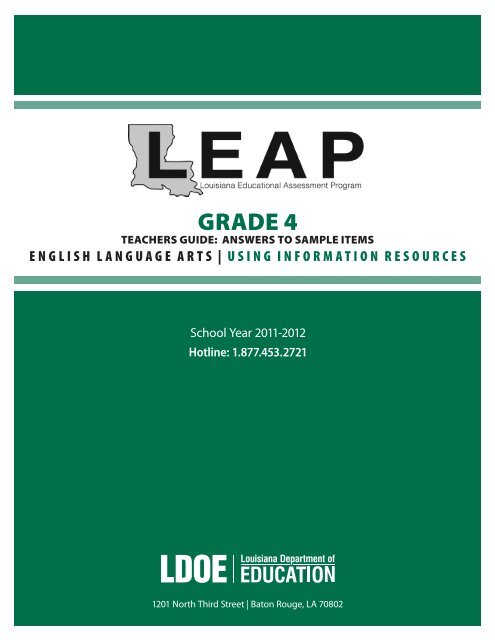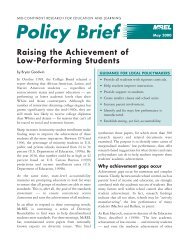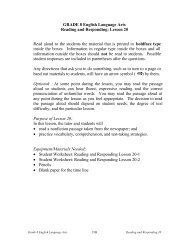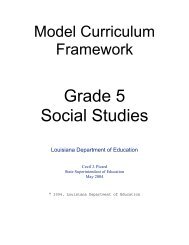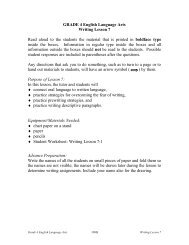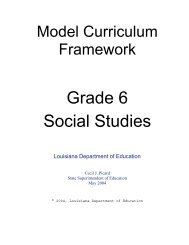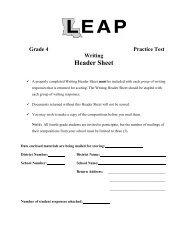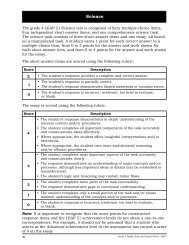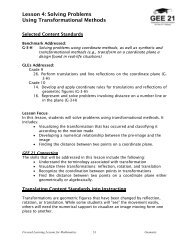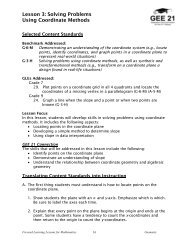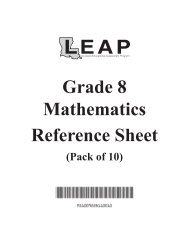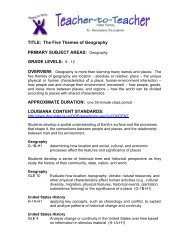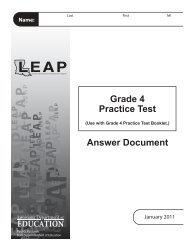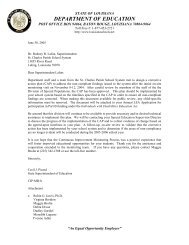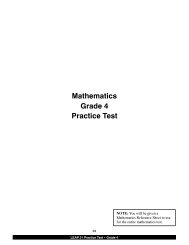Using Information Resources
Using Information Resources
Using Information Resources
You also want an ePaper? Increase the reach of your titles
YUMPU automatically turns print PDFs into web optimized ePapers that Google loves.
GRADE 4TEACHERS GUIDE: ANSWERS TO SAMPLE ITEMSENGLISH LANGUAGE ARTS | USING INFORMATION RESOURCESSchool Year 2011-2012Hotline: 1.877.453.27211201 North Third Street | Baton Rouge, LA 70802
RESEARCH TOPIC: VOLCANOES3. From an Emergency Preparation Handbook“Preparing for a Volcanic Eruption”Emergency PreparednessNatural Disasters - VolcanoesPREPARING FOR A VOLCANIC ERUPTIONPREPARING FOR A VOLCANIC ERUPTIONBefore any emergency, including volcanic eruptions, make sure you know how the city broadcastscommunity warnings. Often these warnings are broadcast on television and radio stations. In some cases,emergency workers go door-to-door in neighborhoods that are in danger.FAMILY PLANSEvery family should have a plan worked out in order to know how to reach each other in an emergency.A real danger of a volcanic eruption (or any other kind of natural disaster) is that family members may beapart when the disaster happens. Family members need to have a plan to get back together. A friend orrelative who lives out of the area may be your emergency contact. All family members should telephonethis person in an emergency.SUPPLIESEveryone should have these supplies ready and available:FlashlightRadioBatteriesFirst aid kitPackaged foodBottled waterCan openerPrescription medicinesBoots or heavy shoesIn the case of a volcanic eruption, you may also need:Dust mask or goggles to keep ashes and dust out of the eyesDisposable breathing maskESCAPE ROUTEIf you live in an area that is close to the volcano, you need to have a plan for an escape route. Planhow you would leave your neighborhood. Be sure to have a backup plan in case your first choiceroute is blocked.ADDITIONAL PREPARATIONSVolcanic eruptions sometimes cause or appear with other disasters. You should also be prepared for:MudslidesEarthquakesTsunamis (tidal waves)Flash floodsAsh fall and acid rainLEAPGrade 4 | Teachers GuideELA | USING INFORMATION RESOURCES5
RESEARCH TOPIC: VOLCANOES4. From the Book All About Volcanoesa. IntroductionYou might think of volcanoes as tall mountainsthat erupt. Some volcanoes do look likemountains. They are tall and cone-shaped. Theseare cinder volcanoes and composite volcanoes.Some volcanoes, shield volcanoes, are shapedlike hills. Shield volcanoes have sides that slopegently, instead of the steep sides of cinder orcomposite volcanoes. Some volcanoes are flatbecause they are just places on the surface of theearth that have split open. These flat volcanoesare fissure volcanoes.What is a volcano? You might say that, in its mostbasic form, a volcano is some kind of openingon the outside layer of the earth, or the earth'scrust. The earth's crust covers the mantle. Theearth's mantle is made of melted rock. It isextremely hot. The melted, liquid rock is calledmagma. The magma of the earth's mantle iscovered by the earth's crust.Sometimes the hot magma is pushed up throughthe earth's crust. The magma pours out of avolcano. This outpouring or release of magma iscalled an eruption. When magma pours out of avolcano, it is called lava. Lava can be thick or thinliquid. Lava is extremely hot. The lava that poursout when a volcano erupts can be as hot as 2,000degrees Fahrenheit.When lava hardens, it can become pumice, astone that is rough and light, with a texturelike a sponge. Lava can look like pillows whenit hardens if the lava is released underwater.The water surrounds the hot lava and cools itvery quickly, giving it a smooth surface. Lavacan harden to be shiny, like glass. Volcanoesalso send out ash and gases. The ash is made ofcrushed hardened lava. The gases are hot andpoisonous. Bits of rock, called debris, also comeout of the volcano.LEAPGrade 4 | Teachers GuideELA | USING INFORMATION RESOURCES6
RESEARCH TOPIC: VOLCANOESacid rain: rain that has acid-forming chemicals that may be dangerous to people and/or harmful to theenvironmentash: fine powder of crushed lava from a volcanic eruptioncinders: bits of hardened lavacrater: the inside of the volcano or geyserdebris: loose pieces of broken rockseruption: the release of steam or molten rock from a geyser or a volcanofumarole: a hole on or near a volcano that sends out steam or vaporgeothermal: related to heat from the earthgeyser: a natural hot spring that sends up jets of hot water and steamhot spring: a water source heated by nearby molten rocklapilli: pebbles sent out by a volcano in an eruptionlava: melted, liquid rock that comes out of a volcano; also the rock that forms when melted lava cools andbecomes solidmagma: hot, melted matter under the earth's surfacemolten: meltedpahoehoe lava: fast-moving liquid lava that hardens to form a smooth surfacepillow lava: lava that has lumps shaped like pillows, formed when lava erupted into the ocean and the lavacooled rapidlypumice: a lightweight stone with a spongelike texture that forms from lava that has gas bubblessulfur: gas that may be released in a volcanic eruptionsummit: the highest part of a volcano5. From the Book All About Volcanoesb. Glossaryvolcano: a hole, split, or vent in the crust of the earth that sends out steam, vapor, lava, gases, or ashesvolcanologist: a scientist who studies volcanoesLEAPGrade 4 | Teachers GuideELA | USING INFORMATION RESOURCES7
RESEARCH TOPIC: VOLCANOES6. Encyclopedia EntryThree Phases of a Volcano1. ACTIVE - Active volcanoes have had recent eruptions. There are signs that show that the volcanomay erupt again.2. DORMANT - Dormant volcanoes have not erupted for many years. There are no signs thatdormant volcanoes will erupt soon, but it is possible for dormant volcanoes to become active andbegin erupting.3. EXTINCT-Extinct volcanoes no longer erupt.Types of VolcanoesThere are four kinds of volcanoes:1. cinder volcano2. shield volcano3. fissure volcano4. composite volcanoCINDERVOLCANOSHIELDVOLCANOFISSUREVOLCANOCOMPOSITEVOLCANOThis volcano ismade of:layers of ashsheets ofhardened lavaearth's crustlayers of ashand lavaThis volcano isshaped like:a conea domea crack inthe eartha coneHow many holesor vents does thisvolcano haveone main ventthat may split off(like tree branches)one hole or ventmay have manyventsone main ventthat may have sidevents (like cindervolcano)LEAPGrade 4 | Teachers GuideELA | USING INFORMATION RESOURCES8
RESEARCH TOPIC: VOLCANOES6. Encyclopedia Entry [continued]Types of LavaThere are three types of lava:1. aa lava2. pahoehoe lava3. pillow lavaAALAVAPAHOEHOELAVAPILLOWLAVAWhat does thislava look like afterit cools?sharp and rockyroperound rocks thatlook like pillowsWhy?It is thick andsticks to things.When it cools,it hardens intosharp rock.It is a thin liquidthat pours outfast.It pours into theocean. The watercools it veryquickly.LEAPGrade 4 | Teachers GuideELA | USING INFORMATION RESOURCES9
LESSON 1 - “VOLCANOES” 1Content Standard:5.2 Locating and evaluating information sourcesIntroduction toStudents:<strong>Using</strong> the computer can be a quick and efficient way to research a topic. When you aretrying to decide whether or not to use a Web site, it is always a good idea to skim overthe information in the short description of the site. This can tell you whether you needto spend time looking at it more carefully.Which Web site should you visit to find out how a volcano on the other side of the world mightinfluence weather in Louisiana?A. Learner.org: Interactive Volcano ExhibitB. NASA Facts Online: Volcanoes and Global CoolingC. Fire on the Mountain: Volcano Power PageD. Geological Encyclopedia: VolcanoesIf you answered A, C, or D, your answer is incorrect. Let’s look at why.A. This Web site tells you facts about volcanoes but says nothing about their influences on other parts of theworld. Read the descriptions of the Web sites listed on the GoFind.org Internet page to help you answerthis question.B. Correct. To find out how a volcano on the other side of the world might influence you in Louisiana,you should visit the NASA Facts Online Web site. In the description of this Web site, you can read that ithas information about whether volcanoes can change Earth’s weather. This certainly could affect us inLouisiana!C. This Web site will give you lots of information about volcanoes, but will it tell you what you need to know?D. Go back and reread the description of this Web site. Will it answer your question?LEAPGrade 4 | Teachers GuideELA | USING INFORMATION RESOURCES10
LESSON 1 - “VOLCANOES” 2Content Standard:5.2 Locating and evaluating information sourcesIntroduction toStudents:When you are trying to decide whether to use a Web site, always read the description.The description can tell you if the site has pictures, facts, virtual tours, projects, etc.Skimming this information is an easy way to know whether or not you want to go tothat site to read more.Which Web site has an activity you could do?A. Learner.org: Interactive Volcano ExhibitB. NASA Facts Online: Volcanoes and Global CoolingC. KidsCrafts.org: Make a VolcanoD. Fire on the Mountain: Volcano Power PageIf you answered A, B, or D, your answer is incorrect. Let’s look at why.A. This Web site will teach you about volcanoes, but does it mention activities? Read the descriptions of theother Web sites to find the one that has a project you can do at home.B. This Web site specifically mentions weather.C. Correct. The Web site that has a project you could work on is KidsCrafts.org.D. This Web site says it has pictures and lots of other information; however, it does not mention activities.LEAPGrade 4 | Teachers GuideELA | USING INFORMATION RESOURCES11
LESSON 2 - “VOLCANOES” 1Content Standard:5.2 Locating and evaluating information sources.Introduction toStudents:Specific information makes a report or project more interesting, and it shows that youhave taken the time to do your research to find out the best information you know howto find.On a test, if you need to know specific information, it is a good idea to go back to thesection of the test where all of the sources are listed in order. Consider each sourcecarefully. Think to yourself, “Will this source possibly have the information that I amlooking for?” For each source that gets a “yes” answer, go to that page and check it out.Remember, you have plenty of time to double-check your answers.Which source gives the name of the highest active volcano?A. "Preparing for a Volcanic Eruption"B. the encyclopedia entryC. the glossaryD. "Volcano Fact Index"If you answered A, B, or C, your answer is incorrect. Let’s look at why.A. The book excerpt gives information on volcanoes, but it does not name the highest active volcano. Skimthe resources listed in the answer choices to help you answer this question.B. The encyclopedia entry gives information on active volcanoes, but it does not name the highest activevolcano.C. The glossary gives some definitions for words related to volcanoes, but it does not name the highestactive volcano.D. Correct. The fact index gives the name of the highest active volcano. The excerpt from the “Volcano FactIndex” states that the highest active volcano (over 22,000 feet high) is named Llullaillaco in Chile.LEAPGrade 4 | Teachers GuideELA | USING INFORMATION RESOURCES12
LESSON 3 - “VOLCANOES” 1Content Standard:5.3 Locating, gathering, and selecting information using graphic organizers, simpleoutlining, note taking, and summarizing to produce texts and graphics.Introduction toStudents:When you are researching a specific or narrowed topic, it is helpful to keep the keyword in mind.In the following question, you are looking for information for a report on lava. Thismeans that each time you look at a source, you need to be looking for your key word,lava. When you are skimming information, look for the word lava to help you decidewhether a source will be useful to you.If you wanted to write a report on lava, which information from All about Volcanoes would bethe most helpful?A. the different kinds of volcanoesB. the shapes that volcanoes can takeC. the definition of pumiceD. the definition of debrisIf you answered A, B, or D, your answer is incorrect. Let’s look at why.A. <strong>Information</strong> about the different kinds of volcanoes would not be the most helpful information in a reportabout lava. Read the book excerpt and the glossary entries again to help you answer this question.B. <strong>Information</strong> about the shapes that volcanoes can take would not be the most helpful information in areport about lava.C. Correct. If you wanted to write a report on lava, of the choices given, the information that would be mosthelpful to you would be the definition of pumice, which is a stone that forms from lava.D. The definition of debris would not be the most helpful information in a report about lava.LEAPGrade 4 | Teachers GuideELA | USING INFORMATION RESOURCES13
LESSON 4 - “VOLCANOES” 1Content Standard:5.6 Interpreting graphic organizers.Introduction toStudents:When you find a chart or graph in the information sources, it has been put there to helpyou find the information you need to know in the shortest amount of time. The best wayto read a chart is to look at the headings that are usually on the top lines and down theleft side. Sometimes it is helpful to use your finger to guide you across or down. Learningto manage charts and graphs can help you to get at the information more quickly.What is a fissure volcano made of?A. layers of ashB. sheets of hardened lavaC. earth’s crustD. layers of ash and lavaIf you answered A, B, or D, your answer is incorrect. Let’s look at why.Use the “Types of Volcanoes” chart in the encyclopedia entry to help you answer this question. Find “fissurevolcano” at the top and “this volcano is made of” on the side. Let your fingers help guide you to the rightanswer.C. Correct. A fissure volcano is made of the earth’s crust.LEAPGrade 4 | Teachers GuideELA | USING INFORMATION RESOURCES14
LESSON 4 - “VOLCANOES” 2Content Standard:5.3 Locating, gathering, and selecting information using graphic organizers, simpleoutlining, note taking, and summarizing to produce texts and graphics.Introduction toStudents:Remember that when you are reading charts or graphs, look at the title, headings, andkey words first. Knowing what kind of chart you are looking at is just as important as theinformation contained within the chart. Remember to use the headings across the topand down the left side to get the information you need.Which volcano is flat?A. cinder volcanoB. composite volcanoC. fissure volcanoD. shield volcanoIf you answered A, B, or D, your answer is incorrect. Let’s look at why.To answer this question, use the “Types of Volcanoes” chart in the encyclopedia entry. Find the row that says,“This volcano is shaped like:” and then follow it to the right to find which type of volcano is flat.C. Correct. The type of volcano that is flat is a fissure volcano.LEAPGrade 4 | Teachers GuideELA | USING INFORMATION RESOURCES15
LESSON 5 - “VOLCANOES” 1Content Standard:5.2 Locating and evaluating information sources.Introduction toStudents:Suppose you have a specific topic you need to look up, and you have a list of resourcesto choose from. Which one do you choose? The best way to know which type of sourceto use is to learn about different sources and how they are used. For example, whatdo you use an encyclopedia for? An index? A timeline? A glossary? Many sources havedifferent types of information about the same topics.When you write the answer to a question, one of the best ways to start your answer isto restate, or repeat, the question you have been given on the test. For example, if thequestion asks, “Which two sources should you use for information about pahoehoelava,” your answer should begin with, “The two sources I used for information aboutpahoehoe lava are. . . ” Each time you answer, practice restating the question. It will helpyou focus on what you need to find for the answer.Which two sources could you use to locate information about pahoehoe lava?Sample Answer: The two sources I used for information about pahoehoe lava are the encyclopedia entry andthe glossary. The encyclopedia entry describes what pahoehoe lava looks like, and the glossary tells what it is.LEAPGrade 4 | Teachers GuideELA | USING INFORMATION RESOURCES16
LESSON 5 - “VOLCANOES” 2Content Standard:5.3 Locating, gathering, and selecting information using graphic organizers, simpleoutlining, note taking, and summarizing to produce texts and graphics.Introduction toStudents:If the question does not specifically identify a source to consult, use key words orcontext clues from the question to determine which source or sources to review. Forexample, based on the phrase “prepare for a volcanic eruption,” you can conclude thatthe best source to use is “Preparing for a Volcanic Eruption.”Once you locate the source, skim the source and select the information that willcorrectly answer the question.What are two things a person should do to prepare for a volcanic eruption?Sample Answer: According to “Preparing for a Volcanic Eruption,” two things a person should do to preparefor a volcanic eruption are to know how your city broadcasts warnings and to make sure you have supplies,like a flashlight, ready.LEAPGrade 4 | Teachers GuideELA | USING INFORMATION RESOURCES17
LESSON 5 - “VOLCANOES” 3Content Standard:5.3 Locating and gathering, and selecting information using graphic organizers, simpleoutlining, note taking, and summarizing to produce texts and graphics.Introduction toStudents:When you are trying to locate information, remember to skim each source for the topicsthat you need. Key words will help you do this more easily. For example, in the questionbelow, what are the key words? (volcanoes, Alaska)When answering constructed-response questions, remember to restate the question.Sometimes, it can make your answer more thorough if you also say where you foundthe information to answer the question. That is especially helpful when you go back todouble check your answers.How many active volcanoes are there in Alaska?Sample Answer: There are sixty active volcanoes in Alaska. I found this information in the Volcano Fact Index.LEAPGrade 4 | Teachers GuideELA | USING INFORMATION RESOURCES18
USING INFORMATION RESOURCESIn this session, you are asked to look at some reference materials and then usethe materials to answer some questions.Research Topic: TransportationSuppose you want to find out more about transportation for a report you are writing. Five differentsources of information about transportation are contained in this session. The information sources arelisted below.1. Internet Web Site <strong>Information</strong> from WideSky.com (pages 98-99)2. From a Book on Transportationa. Table of Contents (page 100)b. Transportation Timeline (page 101)3. From the Newspaper The Grenville Gazette“Letter to the Editor” (page 102)4. From a Book on Airplanesa. Glossary (page 103)b. “Airplane Speed through the Years, 1901-1969” (page 104)5. From the Encyclopedia of Transportation“High-Speed Rail Transportation” (page 105)Skim the resources to become familiar with the information they contain. Remember that theseare references sources, so you should not read every word in each source. Once you have skimmedthese sources, answer the questions that follow. Use the information sources to help you answerthe questions. As you work through the questions, go back and read the parts that will give you theinformation you need.LEAPGrade 4 | Teachers GuideELA | USING INFORMATION RESOURCES19
RESEARCH TOPIC: TRANSPORTATION1. Internet Web Site <strong>Information</strong> from WideSky.comWideSky.comHOME HISTORY NEWS FAQ NEWSLETTERNews, facts, and history of air travelAMERICANHISTORYSEAPLANESULTRALIGHTSSUPERSONICSINTO THEFUTUREAMERICAN HISTORYYou may have heard of the Wright Brothers, but did you know they started out asbicycle mechanics? Orville and Wilbur Wright had transportation in their blood.They owned a bicycle shop in Dayton, Ohio, but they loved flying, be it kites, gliders,or even just watching birds.They flew many homemade gliders and eventually decided to try adding an engine.Their first powered flight ended in a crash landing after only three seconds in the air.Modifications were made, and they tried again. Orville Wright flew for twelveseconds, making this flight the first successful powered flight in history. Since thatday in 1903, many others have worked very hard to make advancements in poweredair travel, resulting in modern jets and space shuttles.Back to top of pageSEA PLANESPlanes can land anywhere, even in water. Only special planes can land in water andstill be able to fly, however. Seaplanes have floats, or pontoons, that allow them toland and to launch from lakes and other calm bodies of water. Water landings allowrescue workers to get to people in emergencies on the water much faster than aboat could get there.Back to top of pageLEAPGrade 4 | Teachers GuideELA | USING INFORMATION RESOURCES20
RESEARCH TOPIC: TRANSPORTATION2. From a Book on Transportationa. Table of ContentsIntroductionHow to Use this BookixxiiiPART ONE: Transportation of the Ancient World1. Rafts, Canoes, Kayaks, and Boats 32. Sleds and Skis 83. The Wheel 12PART TWO: Navigating the Land1. Animals as Vehicles 212. The Bicycle 323. Henry Ford’s Masterpiece: the Automobile 514. Electric Cars 625. High Speed Trains 75PART THREE: Navigating the Water1. Work Boats and Their Uses 812. Submarines: Yesterday and Today 943. Aircraft Carriers 103PART FOUR: Navigating the Air1. History: Gliders and the Wright Brothers 1102. Airplanes: Jets 1183. Blimps and Hot Air Balloons 1214. Supersonic Speeds: The Concorde 1305. Space Shuttles 143PART FIVE: Endless Possibilities - The Future of Transportation 1511. Personal Transportation 1542. Personal Flying Machines: Hovercraft and More 1573. Transportation Beyond Wheels, Engines, and Wings 161Index 167Glossary 171Selected Bibliography 177LEAPGrade 4 | Teachers GuideELA | USING INFORMATION RESOURCES22
RESEARCH TOPIC: TRANSPORTATION2. From a Book on Transportationb. Transportation TimelineThe AncientWorld 1783 1825 1852 1853 1885 1891 1903 1939 1947 1981 1987TheTheHotHotAir Balloon TheTheAir BalloonTheTheElevatorAirplaneElevatorAirplaneThewithTheGasoline EngineswithGasolinePowered EnginesAutomobile PoweredAutomobileGliderswith WingsSleds,Rafts, Rafts,TheBoats,Boats,Skis,Skis,SubmarineCartsCartsTheSteam Steam Train TrainThe JetAirplane AirplaneTheSupersonicSupersonicAirplaneAirplaneSpaceShuttleShuttleMaglevMaglevTrainsTrainsLEAPGrade 4 | Teachers GuideELA | USING INFORMATION RESOURCES23
RESEARCH TOPIC: TRANSPORTATIONaerodynamic: designed to move easily through air and waterAir Cushion Vehicle (ACV): a vehicle that is supported aboveground by a layer of airair pollution: harmful chemicals and other emissions that are produced by vehicles and manufacturingfactories and are released into the airaxle: the bar that runs underneath a vehicle, connecting the wheels on opposite sides.beacon: a signal to warn or guide travelerscatapult: a device for launching a plane from the deck of an aircraft carrier.cockpit: the place on an airplane where all the controls are located and where the pilot uses is seateddrag: forces that slow objects down as they move through air or waterfriction: the force that slows object down when they rub against each otherfuselage: the main body of an airplanehelium: a very stable gas that is lighter than air; used to inflate blimpslift: upward force produced by wings and propeller that causes objects to risesupersonic: faster than the speed of sound.4. From a Book on Airplanesa. GlossaryLEAPGrade 4 | Teachers GuideELA | USING INFORMATION RESOURCES25
RESEARCH TOPIC: TRANSPORTATION4. From a Book on Airplanesb. “Airplane Speed through the Years, 1901-1969”Airplane Speed though the Years, 1901-1969Year Airplane Cruising Speed1901 Wright Biplane 34 mph1933 Boeing 247 (propeller) 189 mph1940 Boeing 307 (propeller) 220 mph1950 Douglas DC6 (propeller) 280 mph1955 Douglas DC7 (propeller) 335 mph1957 Boeing 707 (jet) 600 mph1963 Concorde (supersonic jet) 1,350 mphLEAPGrade 4 | Teachers GuideELA | USING INFORMATION RESOURCES26
RESEARCH TOPIC: TRANSPORTATION5. From the Encyclopedia of Transportation“High-Speed Rail Transportation”High-speed Rail Transportation, continuedTransporting People and GoodsAlthough the design, efficiency, and speeds of trains vary, all trains have one thing in common:they have revolutionized transportation and have had a lasting impact on the world's industry andcivilization. With the introduction of the steam train in 1825, trains became an essential method oftransporting people and goods, such as fruits, vegetables, cattle, and other products.Traveling at Increased SpeedsOver the years, trains have become faster and more efficient. In 1930, the steam train could travel at 125 milesper hour. Twenty years later, the diesel train traveled at 130 miles per hour. In the late 1960s, the Japanesebullet trains of Japan reached a speed of 225 miles per hour. Speeds kept increasing; ten years after the bullettrain's achievement, the German Ice Train's highest recorded speed was 250 miles per hour. The most recentadvancement in speed is the TGV, Train a Grande Vitesse or "High-Speed Train," located in France. The TGV hasa maximum speed of 320 miles per hour, a speed that nearly meets the cruising speed of some jet airplanes.Due to the unusually high speeds of trains like the TGV, there are special modifications to their carsand tracks that are necessary in order to keep these trains safe. The TGV has a "skirt" as part of itsdesign. The skirt prevents the train from rising off the track when traveling at high speeds.High-speed trains demand different tracks from slower trains. Tracks for high-speed trains must besmooth and have few joints. A small bump in a track makes little difference when traveling at lowspeeds. At high speeds, a misplaced joint or a bump in a track could possibly force a train off the track.For this reason, the rails of high-speed trains are built using longer segments. This allows for the useof fewer joints. Another consideration for high-speed trains is that the tracks must take a straightercourse than the tracks of slow-moving trains. Swerving tracks mean slower speeds. The smoother andstraighter the tracks, the faster the trains are able to travel.Long-Distance Train TravelWith the rapidly increasing speeds of trains such as the TGV, long-distance travel on trains maybecome more attractive for travelers than airplane travel. Unlike airports, which are generally locatedoutside city limits, train stations are located in the hearts of cities. The convenient location of trainstations means less travel time altogether.The Future of TrainsThe most recent advances in train technology have produced a new type of train called a Maglev. Thename Maglev was coined from a combination of the words "magnet" and "levitation."The powerful forces of magnets are used to keep these trains above the tracks. This all but eliminatesfriction, allowing the Maglev to travel much faster than other trains. Most trains use wheels that rollon a track. The rubbing of the wheels against the track causes friction, which slows the speed of thetrains. The wheels of the Maglev barely touch the track. It is predicted that in the future Super-Maglevsmay be able to travel up to thousands of miles per hour.Related Articles: History of the Union Pacific Railway-p. 846Monorail-p. 335Steam engine-p. 197Subways and subterranean railways-p. 765LEAPGrade 4 | Teachers GuideELA | USING INFORMATION RESOURCES27
LESSON 6 - “TRANSPORTATION” 1Content Standard:5.2 Locating and evaluating information sources.Introduction toStudents:Books have many sections that can help you find the information within. When you areresearching or trying to find information about a subject, it is a good idea to know howthese sections of books work. Let’s imagine you need to find out what page a certaintopic was on in your textbook. To what section of the book would you go for thatinformation? (the index, where the topics are alphabetized and page numbers are given)It is a good idea to look at the list of sources you are given. This list shows you the kindsof sources you have to work with.Which is the best source for learning about how people traveled long ago?A. the table of contentsB. the glossaryC. the Web site WideSky.comD. the transportation timelineIf you answered B, C, or D, your answer is incorrect. Let’s look at why.A. Correct. Part One of the table of contents is all about transportation in the ancient world. This would bethe best source for finding the information you need.B. Skim the resources listed in the choices again. Does the glossary include information about how peopletraveled long ago?C. Think about the key words in the question “long ago.” The Web site has some information about the firstflight but does not include information about how people traveled long ago.D. The timeline has some information about ways people traveled long ago, but remember, you are lookingfor the best choice.LEAPGrade 4 | Teachers GuideELA | USING INFORMATION RESOURCES28
LESSON 6 - “TRANSPORTATION” 2Content Standard:5.1 Recognizing and using organizational features of printed text, other media, andelectronic information.Introduction toStudents:When using information from the Internet, it is always a good idea to notice how theWeb page is organized before you begin to look for specific information. Skimmingthe information is an important step to see if it will help you on your report. If you lookat the widesky.com Web page, you will notice that each section of information has aheading above it telling you what it contains. Read each one carefully and ask yourself,“Does this contain information that will be useful in my report?”Under which heading of WideSky.com would you learn about who invented the airplane?A. American HistoryB. SeaplanesC. SupersonicsD. Into the FutureIf you answered B, C, or D, your answer is incorrect. Let’s look at why.Neither “Seaplanes,” “Supersonics,” nor “Into the Future” contains information about the invention ofairplanes.A. Correct. If you read the section titled “American History,” you will learn that Orville and Wilbur Wrightmade the first successful flight in an airplane they invented.LEAPGrade 4 | Teachers GuideELA | USING INFORMATION RESOURCES29
LESSON 7 - “TRANSPORTATION” 1Content Standard:5.3 Locating and gathering, and selecting information using graphic organizers, simpleoutlining, note taking, and summarizing to produce texts and graphics.Introduction toStudents:Key words are very important to notice when you are trying to find information ona particular subject. In each question you read, try to decide what the key wordsare. Generally, those key words will be repeated, maybe not exactly but closely, inthe information you are searching. When looking at the information, try to think ofsynonyms, or words that mean the same thing, for the words you are looking for.According to WideSky.com, a plane of the future mightA. land on and take off from water.B. weigh less than many motorcycles.C. travel faster than the speed of light.D. fly around the world in a few hours.If you answered A, B, or C, your answer is incorrect. Let’s look at why.A. Read the section titled “Into the Future” on the widesky.com Web site page and think of key words. Also,use knowledge you already have. Planes can land on water now, and the question asks about planes ofthe future.B. Look under the heading “Ultralights.” Some planes now weigh less than a motorcycle.C. Look under the heading “Supersonics.” Some planes now travel faster than the speed of sound.D. Correct. You can find this information in the section titled “Into the Future.” It states, “NASA (NationalAeronautics and Space Administration) is working on a plane that would be able to travel around theentire world in only a few hours.” According to this source, this hasn’t happened yet, but it may in thefuture.LEAPGrade 4 | Teachers GuideELA | USING INFORMATION RESOURCES30
LESSON 7 - “TRANSPORTATION” 2Content Standard:5.6 Interpreting graphic organizers.Introduction toStudents:A timeline is a list of topics organized according to time. Timelines are helpful to usebecause they organize a topic, in this case transportation, in the order of the datesin which events happened. When studying a timeline, notice what comes first, whatcomes last, and skim what happens in the middle. When a date is given to you, be sureto locate that exact date on the timeline.According to the transportation timeline, the steam train was invented inA. 1783.B. 1825.C. 1885.D. 1987.If you answered A, C, or D, your answer is incorrect. Let’s look at why.A. Find the steam train on the transportation timeline. Follow the line from the steam train to the date aboveto find when the steam train was invented.B. Correct. Locating information on a timeline is as easy as finding the information you need and followingthe line to the date.C. Same as A.D. Same as A.LEAPGrade 4 | Teachers GuideELA | USING INFORMATION RESOURCES31
LESSON 8 - “TRANSPORTATION” 1Content Standard:5.6 Interpreting graphic organizers.Introduction toStudents:Most timelines are organized so that they are easy for the reader to use and understandthe information. After you look at the first date and the last date and skim theinformation in the middle, notice how the timeline moves. Generally, the oldest datewill be on the left and the most recent date will be on the right. Some timelines usepictures to help you understand the topics.According to the transportation timeline, which was invented first?A. Maglev trainsB. submarinesC. automobilesD. elevatorsIf you answered A, B, or C, your answer is incorrect. Let’s look at why.A. Think about the setup of this timeline. The dates on the timeline are read from left to right, oldest to mostrecent. Of the four choices listed, which was the oldest invention?B. Same as A.C. Same as A.D. Correct. Out of the four choices, the elevator is the answer choice that is farthest to the left, whichindicates it is the oldest and was invented first.LEAPGrade 4 | Teachers GuideELA | USING INFORMATION RESOURCES32
LESSON 9 - “TRANSPORTATION” 1Content Standard:5.1 Recognizing and using organizational features of printed text, other media, andelectronic information.Introduction toStudents:Most books about a specific subject have sections called glossaries to help you findwords and their meanings as they are used in the source. One difference betweenglossaries and dictionaries is that dictionaries have most of the words in the Englishlanguage in them, and glossaries include definitions of words that will help youunderstand the topic of the book. Always try to look up words that you don’t knowwhile you are reading. This is helpful not only for understanding, but also for savingtime by your learning the word the first time you read it.Which source would be the best place to find the difference between a fuselage and a cockpit?A. the table of contentsB. the glossaryC. the transportation timelineD. the letter to the editorIf you answered A, C, or D, you will need to try again. Let’s look at why.A. The table of contents only gives page numbers where specific topics can be found.B. Correct. The best place to find the difference between a fuselage and a cockpit is the glossary.C. The transportation timeline tells us dates when certain types of transportation were invented.D. D. A letter to the editor is written by someone who reads that newspaper.LEAPGrade 4 | Teachers GuideELA | USING INFORMATION RESOURCES33
LESSON 9 - “TRANSPORTATION” 2Content Standard:5.6 Interpreting graphic organizers.Introduction toStudents:Charts are used together with text to help the reader and researcher to compare andcontrast, or find similarities and differences, between different subjects.Charts and graphs organize a lot of information in an easy-to-read format. Whenreading charts, first locate the headings for each section. Then, look at what is underthose headings. Sometimes, people find it helpful to use their fingers to guide themthrough a chart.According to “Airplane Speed through the Years,” which airplane has a cruising speed of 280 mph?A. Boeing 247B. Douglas DC6C. Boeing 707D. ConcordeIf you answered A, C, or D, you will need to try again. Let’s look at why.To find this answer, first look for 280 mph in the column labeled “Cruising Speed.” Then find the airplane tothe left of 280 mph.B. Correct. The airplane that cruises at 280 mph is the Douglas DC6.LEAPGrade 4 | Teachers GuideELA | USING INFORMATION RESOURCES34
LESSON 10 - “TRANSPORTATION” 1Content Standard:5.2 Locating and evaluating information sources.Introduction toStudents:One key to answering questions is understanding the meaning of the words “bestanswer.” Some questions have more than one answer choice that may be partly correct.This means that you have to go back to each source and check it out. Make certain thatyou are choosing the best answer.Which source would you use to learn more about different types of trains?A. the table of contentsB. the transportation timelineC. "High-Speed Rail Transportation"D. the Web site WideSky.comIf you answered A, B, or D, your answer is incorrect. Let’s look at why.A. The table of contents lists some information about high-speed trains, but it would not be the best sourceto find information about different types of trains. Skim the four choices listed to find which one wouldbest give you the information you need.B. The transportation timeline lists two kinds of trains, but it does not explain them.C. Correct. The best source to use to learn more about different types of trains is “High-Speed RailTransportation.”D. The Web site WideSky.com contains information about airplanes and not trains.LEAPGrade 4 | Teachers GuideELA | USING INFORMATION RESOURCES35
LESSON 11 - “TRANSPORTATION” 1Content Standard:5.1 Recognizing and using organizational features of printed text, other media andelectronic information.Introduction toStudents:An index is organized in alphabetical order to make it easy to find the information youneed. Looking up page numbers in an index is a great way to save time and locateuseful information.When answering a constructed-response question, one of the best ways to start youranswer is to restate, or repeat, the question you have been given on the test. Forexample, read the question below. How would you restate that question in the first partof your answer? (I can find the information about a coaster built in Arlington, Texas, in2000 on…) By restating the question, you learn to focus on what you are looking forand you let the reader know exactly what you mean.According to the table of contents, in which part and chapter would you find informationabout submarines?Sample Answer: According to the table of contents, information about submarines would be found in PartThree, Chapter 2.Always reread the question and your answer to make sure that you answered each part of the question.LEAPGrade 4 | Teachers GuideELA | USING INFORMATION RESOURCES36
LESSON 11 - “TRANSPORTATION” 2Content Standard:5.2 Locating and evaluating information sources.Introduction toStudents:Sometimes when you are researching, you have to judge which sources are the bestsources to use. Often, topics will be mentioned in other sources, but there will be muchbetter information in another source. In this case, you will be required to use your bestjudgment—that means you will have to go back to each source to decide which one isbest and why.Always look for words like most, best, always, never, and least when reading a questionon a test. These will help you to know exactly what you have to do to answer thequestion the best that you can.Name two sources from the provided resources which contain information about space travel.Sample Answer: The two most helpful sources for learning about space travel are widesky.com and the tableof contents. These two sources are the most helpful because widesky.com contains a section about “intothe future” and “NASA.” The table of contents tells you that information about space shuttles and futuretransportation is available in that book.LEAPGrade 4 | Teachers GuideELA | USING INFORMATION RESOURCES37
LESSON 11 - “TRANSPORTATION” 3Content Standard:5.3 Locating and gathering, and selecting information using graphic organizers, simpleoutlining, note taking, and summarizing to produce texts and graphics.Introduction toStudents:When you are trying to locate information, remember to skim each source for the topicsthat you need. Key words will help you do this more easily. For example, in the questionbelow, what are the key words? (Wright brothers)Remember, you may see your topic in more than one source, but you must decidewhich source you would use first because it has the best and most information.If you were writing a report about the Wright brothers, which source from the providedresources would be most helpful?Sample Answer: If I were writing a report about the Wright brothers, I would first use widesky.com because itprovides the most information.Of the sources that you are given, widesky.com gives you the most information about the Wright Brothers.LEAPGrade 4 | Teachers GuideELA | USING INFORMATION RESOURCES38


